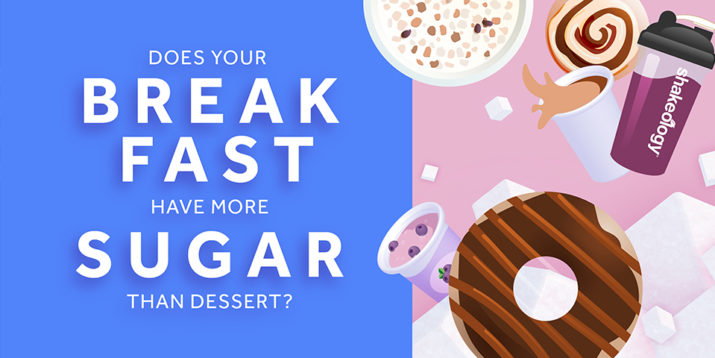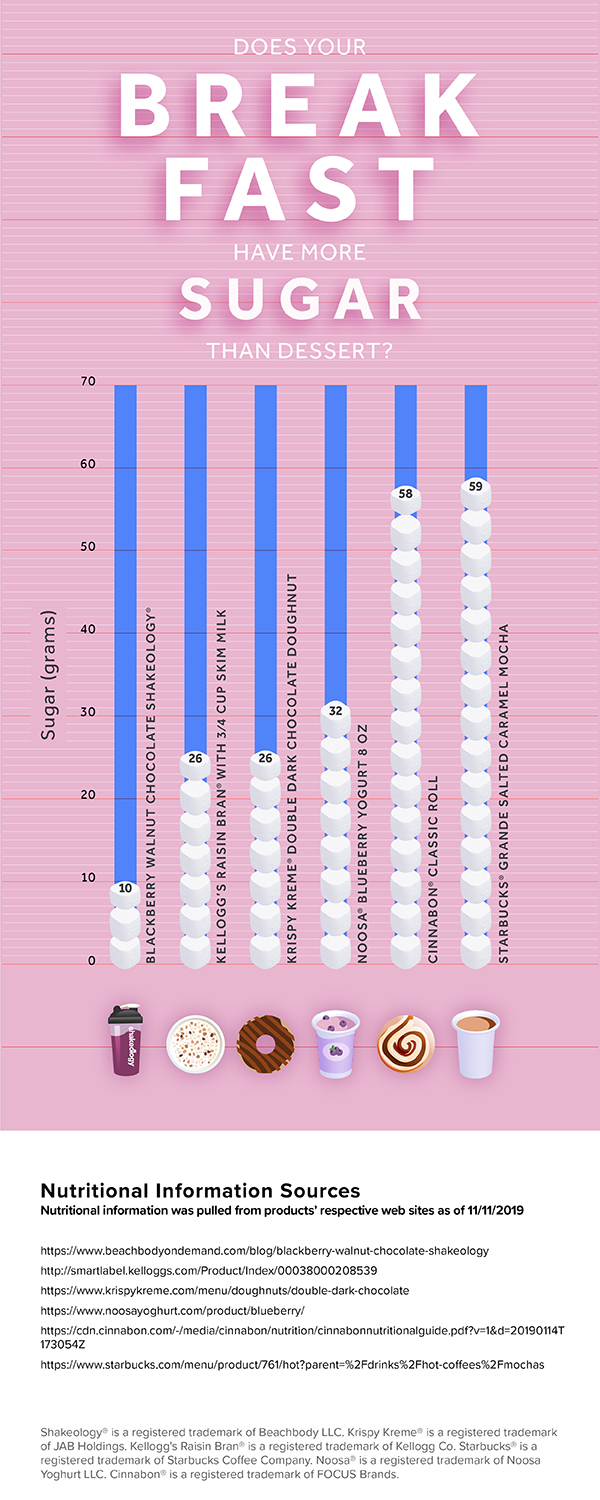How Much Sugar Is Hiding in Your Breakfast?

How much sugar are you eating at breakfast? It’s probably more than you think.
With tons of sugary breakfast options like pancakes, waffles, doughnuts, and sugar-coated cereal, it’s clear that many Americans love to get the day started with a sweet treat.
But even those who opt for healthier options may be getting far more sugar than they think.
Research shows that the average American breakfast contains more sugar than any other single macronutrient like protein, fiber, or complex carbs.
Despite the trend towards higher-protein, lower-sugar breakfasts, as a nation, we’re still consuming loads of the sweet stuff — sometimes unwittingly.
“People are still eating a lot of sugar in the morning, and people are getting a lot of sugar from so-called healthy breakfasts,” explains researcher Heather Leidy, Ph.D., associate professor of nutritional sciences and pediatrics at the University of Texas, Austin, who studies meal quality, and the impact of meal-timing on the body.
Why a Sugary Breakfast Is No Bueno
Here’s why it matters: A balanced breakfast, filled with protein and fiber, and not a lot of added sugar, has all kinds of benefits.
Research shows that a nutritious, high-protein, high-fiber breakfast may help you snack less and eat fewer sugary foods throughout the day, fill you up and keep you full for longer, reduce your overall daily food intake, and support cognitive function and performance compared to skipping breakfast.
Eating a breakfast that’s loaded with sugar or refined carbohydrates, on the other hand, sets you off on a roller coaster of energy highs and lows for the day, says Krista Maguire, R.D.
Sugary meals, Maguire explains, do not supply a steady source of energy.
And when your blood sugar levels inevitably dip, you’re often left hungry, tired, irritable, and more likely to crave even more sugary foods.
So How Much Sugar Are We Talking?
The American Heart Association recommends that women eat no more than 25 grams of added sugar (6 teaspoons) per day. Men, they say, should limit their daily intake to 36 grams (9 teaspoons).
But the reality is that the average adult eats 77 grams of added sugar a day — three times the recommended amount for women and more than twice the limit for men.
To put that in perspective, that’s 60 pounds of added sugar per year, or more than a pound of sugar a week. Meanwhile, kids eat more than 65 pounds of sugar a year.
Twenty-five percent of that comes from breakfast. By the time we’ve shoveled down a quick morning bite, the typical American has swallowed close to 20 grams of sugar — nearly the equivalent of six Chips Ahoy!® original cookies.
A quick primer on sugar content and deciphering food labels: There’s naturally occurring sugar and then there’s added sugar.
Fruit, starchy vegetables, and dairy products have naturally occurring sugar and aren’t generally worrisome from a health standpoint when eaten as a whole food versus juice, for example.
One small banana contains 12.4 grams of naturally occurring sugar. “Added sugar” is any sweetener (think honey, agave, corn syrup, cane juice) added to a product during manufacturing or preparation.
“Total sugar” is the sum of naturally occurring sugars and added sugar.
Related: What’s the Difference Between Added Sugar and Total Sugar?
Where Is the Sugar Hiding?
You don’t have to down half a box of Frosted Flakes® to go overboard on sugar: A one-cup serving of the cereal has 14 grams of total sugar, all of which come from added sugar.
Compare that to a ¾ cup serving of Kashi® GO® Crunch!® Honey Almond Flax cereal, which contains 12 grams of sugar, 10 of which are added sugar.
Likewise, a blueberry muffin might seem like the healthier choice at a doughnut shop when faced with rows of chocolate-frosted, rainbow-sprinkled, cream-filled O’s.
However, most blueberry muffins have more added sugar than every doughnut on the menu.
At 44 grams of total sugar (41g added), a Dunkin’® blueberry muffin equals not one, but two Entenmann’s® Chocolate Crème Filled Cupcakes.
So, skip the muffin and just grab a coffee?
The worst sugar offenders on many menus aren’t from the bakery — they’re from the café.
A large Peppermint Mocha Swirl Frozen Chocolate from Dunkin® contains 163 grams of total sugar. You could have two slices of Chocolate Mousse Cheesecake from The Cheesecake Factory® and still have eaten less total sugar.
Below, we’ve put together a chart that compares the amount of sugar in common breakfast items, like a Starbucks® Grande Salted Caramel Mocha or blueberry yogurt to popular dessert items, like doughnuts and cinnamon rolls.
Our Blackberry Walnut Chocolate Shakeology recipe with Chocolate Whey Shakeology comes in at 10 grams of total sugar, with 5 of those coming from added sugar.
Try out the recipe for a quick, high-protein, high-fiber, nutrient-dense breakfast that won’t load you down with added sugar, but can fill you up to help you eat less and make healthier choices throughout the day.

